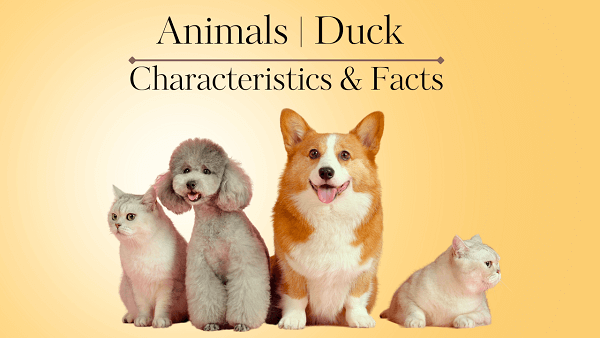Duck Definition | Characteristics & Facts
Home » Animals » Duck Definition | Characteristics & Facts
Duck Definition
A duck is a type of bird belonging to the family Anatidae, which also includes swans and geese. Ducks are characterized by their medium-sized to large bodies, short necks, and rounded bills.
Duck General Characteristics & Facts
Waterfowl
Ducks are waterfowl birds, adapted for life in and around bodies of water such as lakes, rivers, wetlands, and ponds.
Feathers
Ducks have waterproof feathers that keep them insulated and buoyant in the water. They have a dense layer of fluffy down feathers close to their body and outer feathers that repel water.
Webbed Feet
Webbed feet help them swim efficiently in water. The webbing between their toes provides paddle-like structures for propulsion.
Beak
Ducks have broad and flat beak, which varies in shape depending on their diet. Some ducks have specialized beaks for filtering small organisms from the water, while others have beaks for grazing on vegetation or catching prey.
Diet
Ducks are omnivorous, feeding on a wide variety of food. They eat aquatic plants, seeds, insects, crustaceans, mollusks, small fish, and amphibians.
Migration
Many duck species are migratory, traveling long distances between their breeding grounds and wintering grounds. They undertake these migrations in search of suitable habitats and food sources.
Social Behavior
Ducks are social birds and often form flocks, particularly during migration or wintering periods. Vocalizations and body language are two communication ways.
Reproduction
Ducks mostly form monogamous pairs during the breeding season. Females build nests on the ground, in vegetation, or in tree cavities, and lay a clutch of eggs. Both parents participate in incubating the eggs and raising the young ducklings.
Flying Abilities
Ducks are capable flyers, using their strong wing muscles to propel themselves through the air. They have a characteristic flying pattern, with their necks outstretched and legs trailing behind.
Species Diversity
There are numerous species of ducks worldwide, with diverse appearances and behaviors. Some well-known species include Mallards, Pintails, Wood Ducks, Muscovy Ducks, and Mandarin Ducks.
Economic and Ecological Importance
Ducks have cultural, economic, and ecological significance. They are hunted for sport and food in some regions. Additionally, ducks contribute to ecosystem health by dispersing seeds, controlling aquatic insect populations, and serving as prey for other animals.
Adaptability
Ducks are adaptable birds and can be found in various habitats, including freshwater lakes, rivers, swamps, coastal areas, and even urban environments.
Diving Ability
Many duck species are capable of diving underwater to search for food. They can stay submerged for short periods and use their specialized beaks to catch prey or forage on aquatic vegetation.
Vocalizations
Ducks produce a variety of sounds, including quacks, whistles, and grunts. These vocalizations serve as a means of communication, signaling danger, attracting mates, or maintaining social cohesion.
Conservation Status
Some duck species face conservation concerns due to habitat loss, pollution, hunting pressure, and climate change. Conservation efforts are in place to protect and preserve their populations and habitats.
Read our Animals Encyclopedia with Complete Facts
Duck Physical Characteristics
- Size: They can range from small ducks, such as the Bufflehead, which measures around 13-16 inches (33-41 cm) in length, to larger species like the Mallard, which can reach lengths of about 20-26 inches (51-66 cm).
- Body Shape: Ducks have a compact and streamlined body shape, designed for swimming and diving in water. They have a rounded, slightly elongated body with a broad chest and a short tail.
- Feathers: Ducks have waterproof feathers that help keep them dry while swimming.
- Webbed Feet: Ducks have webbed feet, which are specialized for efficient swimming. The toes are connected by webbing, enabling them to paddle through the water and navigate with ease.
- Bill: Ducks have a characteristic bill that varies in shape and size depending on the species. The bill is typically broad, flat, and covered with a hard keratinous material. The bill’s shape can be adapted for different feeding behaviors, such as filtering small organisms from the water, probing mud for invertebrates, or grasping and tearing plant material.
- Wings: Ducks have strong and agile wings that allow them to fly. Their wings have evolved for both powered flight and gliding. During the flight, ducks exhibit rapid and continuous wingbeats.
- Sexual Dimorphism: In many duck species, males and females display sexual dimorphism, which means they have different physical characteristics.
Continue To Explore All Animals That Start With D
Duck Scientific Classification
Kingdom: Animalia
Phylum: Chordata
Class: Aves
Order: Anseriformes
Family: Anatidae
Subfamily: Anatinae
Genus: Anas (for most common ducks)
Species: Various species within the genus Anas, such as Anas platyrhynchos (Mallard) or Anas acuta (Northern Pintail)
Key Locations of Duck
- United States
- Canada
- United Kingdom
- Australia
- China:
- Russia
- Argentina
- Mexico
- Sweden
- Brazil
View All A-Z Animals List
Duck FAQs
What Duck Eats the Most?
- Aquatic Plants
- Invertebrates
- Seeds and Grains
- Small Fish and Amphibians
- Small Mammals
- Insects and Larvae
- Grass and Plant Shoots
What is a female sheep called?
A female sheep is called a ewe.
What is a castrated male sheep called?
A castrated male sheep is called a wether.
What is the term for the act of giving birth to a lamb?
The act of giving birth to a lamb is called lambing.
How many stomachs does a sheep have?
Like other ruminant animals, sheep have four stomach compartments: the rumen, reticulum, omasum, and abomasum.
What is the process of removing wool from a sheep called?
It is called shearing.
How many teeth do adult sheep typically have?
Adult sheep typically have 32 teeth. They have incisors in the lower and upper jaws, along with premolars and molars in the back of the mouth.



